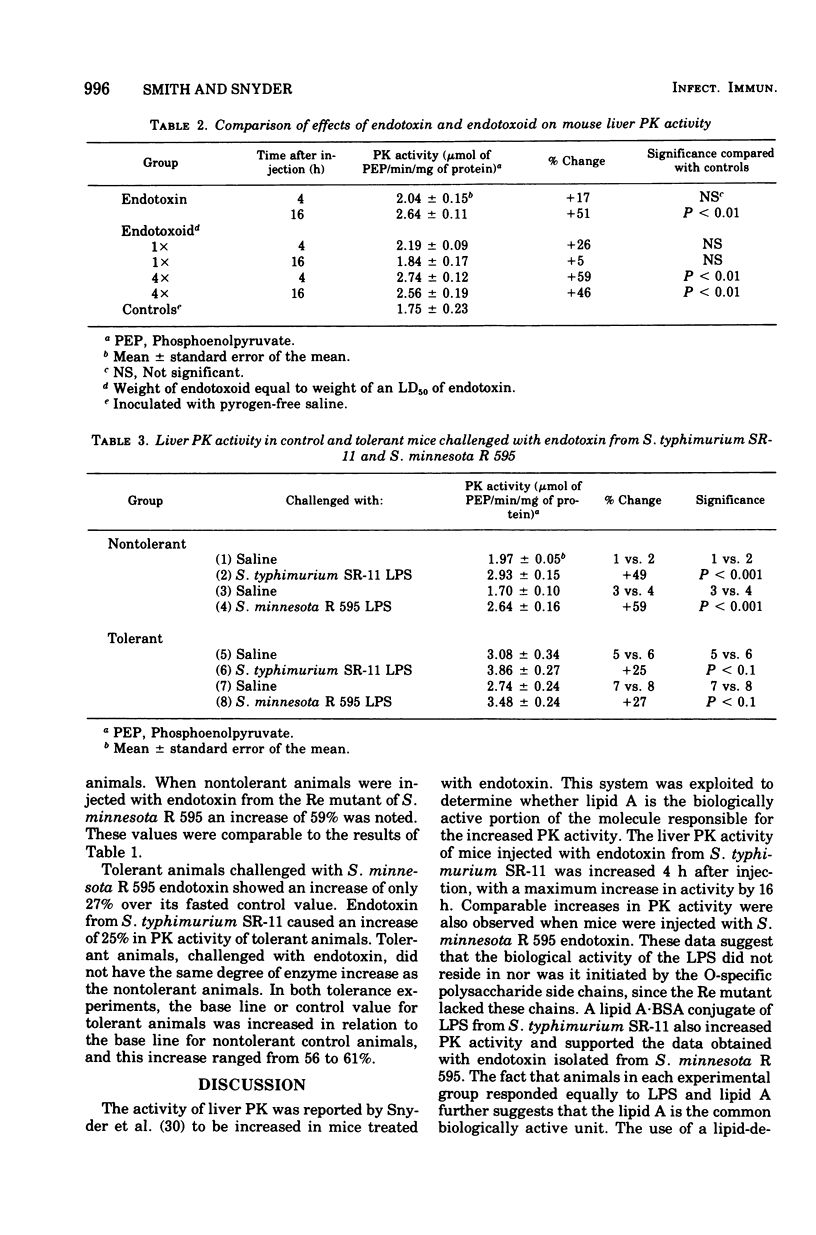Abstract
Several investigators have reported lipid A as the biologically active unit in the lipopolysaccharide (LPS) molecule. To determine if lipid A was responsible for the reported increases in pyruvate kinase, mice were injected with endotoxin from Salmonella typhimurium SR-11, the Re mutant of Salmonella minnesota R 595, and lipid A-bovine serum albumin conjugate. The livers were homogenized and the activity of pyruvate kinase was measured. Similar increases in enzyme were obtained with all three preparations. These data imply that the lipid portion of the LPS molecule was responsible for alterations in host enzyme activity. To further determine if the lipid portion was the active unit, a lipid-degraded endotoxin (endotoxoid) prepared by potassium methylate treatment was inoculated into mice. An initial increase in liver pyruvate kinase activity was observed with all preparations. The marked increase observed at 16 h with the native product and lipid A conjugate was not obtained with the endotoxoid. These experiments extend and confirm previous observations that lipid A is responsible for the effects associated with LPS. Animals tolerant to endotoxin from S. typhimurium SR-11 were challenged with endotoxin from the Re mutant. A significant increase in pyruvate kinase activity was not obtained, suggesting that anti-O antibodies are not important in the development of tolerance.
Full text
PDF





Selected References
These references are in PubMed. This may not be the complete list of references from this article.
- BERRY L. J., SMYTHE D. S., YOUNG L. G. Effects of bacterial endotoxin on metabolism. I. Carbohydrate depletion and the protective role of cortisone. J Exp Med. 1959 Sep 1;110:389–405. doi: 10.1084/jem.110.3.389. [DOI] [PMC free article] [PubMed] [Google Scholar]
- Berry L. J., Smythe D. S., Colwell L. S. Inhibition of hepatic enzyme induction as a sensitive assay for endotoxin. J Bacteriol. 1968 Oct;96(4):1191–1199. doi: 10.1128/jb.96.4.1191-1199.1968. [DOI] [PMC free article] [PubMed] [Google Scholar]
- Berry L. J., Smythe D. S. Some metabolic aspects of tolerance to bacterial endotoxin. J Bacteriol. 1965 Oct;90(4):970–977. doi: 10.1128/jb.90.4.970-977.1965. [DOI] [PMC free article] [PubMed] [Google Scholar]
- Galanos C., Lüderitz O., Westphal O. A new method for the extraction of R lipopolysaccharides. Eur J Biochem. 1969 Jun;9(2):245–249. doi: 10.1111/j.1432-1033.1969.tb00601.x. [DOI] [PubMed] [Google Scholar]
- Galanos C., Rietschel E. T., Lüderitz O., Westphal O. Interaction of lipopolysaccharides and lipid A with complement. Eur J Biochem. 1971 Mar 1;19(1):143–152. doi: 10.1111/j.1432-1033.1971.tb01298.x. [DOI] [PubMed] [Google Scholar]
- Galanos C., Rietschel E. T., Lüderitz O., Westphal O., Kim Y. B., Watson D. W. Biological activities of lipid A complexed with bovine-serum albumin. Eur J Biochem. 1972 Dec 4;31(2):230–233. doi: 10.1111/j.1432-1033.1972.tb02524.x. [DOI] [PubMed] [Google Scholar]
- Greisman S. E., DuBuy B. Mechanisms of endotoxin tolerance. IX. Effect of exchange transfusion. Proc Soc Exp Biol Med. 1975 Mar;148(3):675–678. doi: 10.3181/00379727-148-38608. [DOI] [PubMed] [Google Scholar]
- Hämmerling U., Westphal O. Synthesis and use of O-stearoyl polysaccharides in passive hemagglutination and hemolysis. Eur J Biochem. 1967 Mar;1(1):46–50. doi: 10.1007/978-3-662-25813-2_9. [DOI] [PubMed] [Google Scholar]
- Kim Y. B., Watson D. W. Biologically active endotoxins from Salmonella mutants deficient in O- and R-polysaccharides and heptose. J Bacteriol. 1967 Nov;94(5):1320–1326. doi: 10.1128/jb.94.5.1320-1326.1967. [DOI] [PMC free article] [PubMed] [Google Scholar]
- Kim Y. B., Watson D. W. Role of antibodies in reactions to gram-negative bacterial endotoxins. Ann N Y Acad Sci. 1966 Jun 30;133(2):727–745. doi: 10.1111/j.1749-6632.1966.tb52402.x. [DOI] [PubMed] [Google Scholar]
- Lüderitz O., Galanos C., Risse H. J., Ruschmann E., Schlecht S., Schmidt G., Schulte-Holthausen H., Wheat R., Westphal O., Schlosshardt J. Structural relationship of Salmonella O and R antigens. Ann N Y Acad Sci. 1966 Jun 30;133(2):349–374. doi: 10.1111/j.1749-6632.1966.tb52376.x. [DOI] [PubMed] [Google Scholar]
- McCabe W. R. Immunization with R mutants of S. Minnesota. I. Protection against challenge with heterologous gram-negative bacilli. J Immunol. 1972 Mar;108(3):601–610. [PubMed] [Google Scholar]
- McCallum R. E., Berry L. J. Effects of endotoxin on gluconeogenesis, glycogen synthesis, and liver glycogen synthase in mice. Infect Immun. 1973 Apr;7(4):642–654. doi: 10.1128/iai.7.4.642-654.1973. [DOI] [PMC free article] [PubMed] [Google Scholar]
- McCallum R. E., Berry L. J. Mouse liver fructose-1, 6-diphosphatase and glucose-6-phosphatase activities after endotoxin poisoning. Infect Immun. 1972 Nov;6(5):883–885. doi: 10.1128/iai.6.5.883-885.1972. [DOI] [PMC free article] [PubMed] [Google Scholar]
- Mullan N. A., Newsome P. M., Cunnington P. G., Palmer G. H., Wilson M. E. Protection against gram-negative infections with antiserum to lipid A from Salmonella minnesota R595. Infect Immun. 1974 Dec;10(6):1195–1201. doi: 10.1128/iai.10.6.1195-1201.1974. [DOI] [PMC free article] [PubMed] [Google Scholar]
- NOWOTNY A. Endotoxoid preparations. Nature. 1963 Feb 16;197:721–722. doi: 10.1038/197721b0. [DOI] [PubMed] [Google Scholar]
- Nowotny A. Molecular aspects of endotoxic reactions. Bacteriol Rev. 1969 Mar;33(1):72–98. doi: 10.1128/br.33.1.72-98.1969. [DOI] [PMC free article] [PubMed] [Google Scholar]
- Rietschel E. T., Kim Y. B., Watson D. W., Galanos C., Lüderitz O., Westphal O. Pyrogenicity and immunogenicity of lipid A complexed with bovine serum albumin or human serum albumin. Infect Immun. 1973 Aug;8(2):173–177. doi: 10.1128/iai.8.2.173-177.1973. [DOI] [PMC free article] [PubMed] [Google Scholar]
- Shands J. W., Jr Evidence for a bilayer structure in gram-negative lipopolysaccharide: relationship to toxicity. Infect Immun. 1971 Aug;4(2):167–172. doi: 10.1128/iai.4.2.167-172.1971. [DOI] [PMC free article] [PubMed] [Google Scholar]
- Shands J. W., Jr, Miller V., Martin H., Senterfitt V. Hypoglycemic activity of endotoxin. II. Mechanism of the phenomenon in BCG-infected mice. J Bacteriol. 1969 May;98(2):494–501. doi: 10.1128/jb.98.2.494-501.1969. [DOI] [PMC free article] [PubMed] [Google Scholar]
- Snyder I. S., Deters M., Ingle J. Effect of endotoxin on pyruvate kinase activity in mouse liver. Infect Immun. 1971 Aug;4(2):138–142. doi: 10.1128/iai.4.2.138-142.1971. [DOI] [PMC free article] [PubMed] [Google Scholar]
- Snyder I. S. Enzyme activities of the livers of mice infected with Salmonella typhimurium. Infect Immun. 1971 Oct;4(4):411–415. doi: 10.1128/iai.4.4.411-415.1971. [DOI] [PMC free article] [PubMed] [Google Scholar]
- WATSON D. W., KIM Y. B. MODIFICATION OF HOST RESPONSES TO BACTERIAL ENDOTOXINS. I. SPECIFICITY OF PYROGENIC TOLERANCE AND THE ROLE OF HYPERSENSITIVITY IN PYROGENICITY, LETHALITY, AND SKIN REACTIVITY. J Exp Med. 1963 Sep 1;118:425–446. doi: 10.1084/jem.118.3.425. [DOI] [PMC free article] [PubMed] [Google Scholar]
- WEBER G., STAMM N. B., FISHER E. A. INSULIN: INDUCER OF PYRUVATE KINASE. Science. 1965 Jul 2;149(3679):65–67. doi: 10.1126/science.149.3679.65. [DOI] [PubMed] [Google Scholar]


